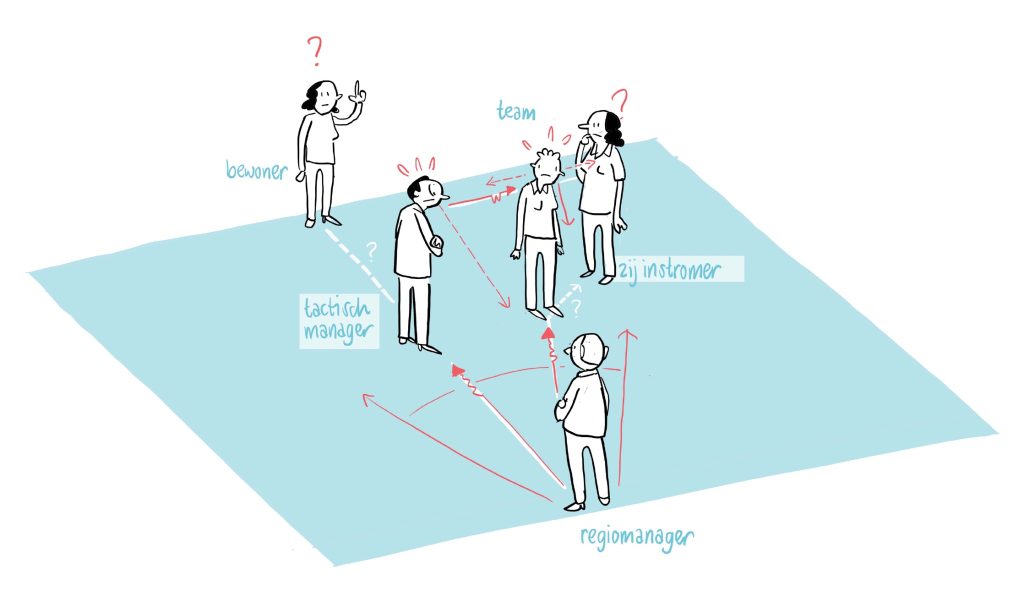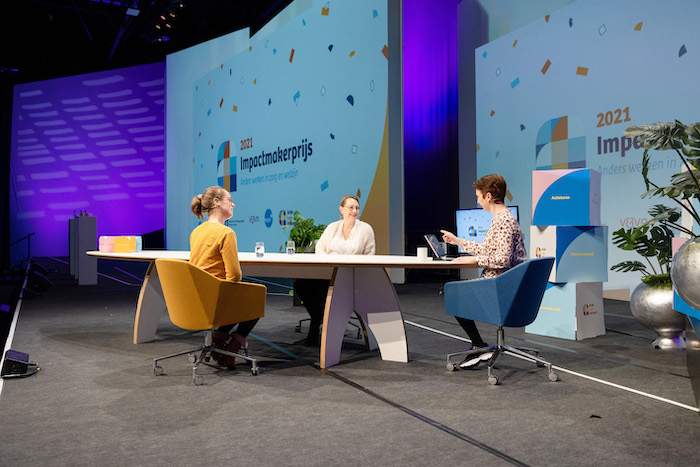Improve your retention policy with… stories!
Improving employee retention? Put their lived experiences at the center and ensure fewer cracks and more bright spots within it.
Are you interested?
Would you like to discover how you can use narrative research and a participatory approach to retain staff? Then schedule an appointment now for an exploratory conversation.
Retention trumps recruiting
In the current tight labor market, the front door of many organizations is wide open for new staff, but unfortunately this also applies to the back door. Replacing a departed employee entails significant costs, such as hiring temporary workers, recruitment, induction and training costs. And in the social field, relationships must be reset. A targeted employee retention policy is no longer a luxury, but an absolute necessity. In terms of effectiveness, retention exceeds recruitment on all aspects.
At StoryConnect we believe in the power of stories in tackling complex issues such as employee retention and creating a safe and inclusive culture. Experience stories, storylistening and a participatory approach are the key to improving your staff retention and inclusivity.
Stories reveal what lies behind the numbers
Statistically oriented research, such as satisfaction measurements, inflow and outflow analyses, etc. provide valuable figures about numbers, quantities and correlations between them. When it comes to retention, the figures are often difficult to translate into concrete policy measures and specific interventions that go beyond just improved onboarding and leadership training. Most organizations have already invested a lot in this and in many cases the law of diminishing returns applies.
Behind the numbers are unique working environments. Context-related dynamics in these working environments remain out of the picture in the numerical studies and that is precisely where important causes of departure often lie. Gaining insight into this is crucial for a differentiated retention policy aimed at improving staff retention. Stories are varied in content and cannot be averaged or added up. Patterns can be spotted in quite a few stories. Patterns that play tricks on the narrators, for example.
Our story-based approach works with variety and focuses on identifying the positive and negative patterns. These provide a source for policy and interventions aimed at improving conservation and inclusivity. This is often not 'one size for all' but targeted customization with multiple and different experiments in accordance with the principle of: variety beats variety.
The issue of conservation is therefore not just about counting, but above all about telling.
From the world of the storyteller
Stories emerge from the world of the storytellers. In that living environment, experiences are formed that are given meaning by the storyteller in the story, with emotion and motivation. A departing employee draws on his or her world when making a personal decision, for example to leave or to stay.
The stories include stories about 'hairline cracks' and 'bright spots' - disappointing work experiences that generate negative emotions and positive experiences in the form of small successes that actually contribute to job satisfaction and well-being.
Multiple and accumulating hairline cracks pose a risk of breakage. These 'hairline cracks' and 'bright spots' provide valuable starting points for searching for targeted improvements to a working environment and breaking any negative patterns. Policy and interventions can be aimed, among other things, at (timely) gluing hairline cracks and encouraging and ensuring the emergence of bright spots to create flow experiences.

Undercurrents emerge in stories
Not always pronounced, but palpably present within the organization, undercurrents are fed by locally formed behaviors, beliefs or habits that are often shared informally, for example at the coffee machine. The beliefs and local interpretations of events can spread unnoticed and nestle in the collective memory, creating underlying patterns that escape the eye. Unfortunately, these patterns can have a negative impact on mutual relationships, cooperation and manners in the organization. Sometimes this manifests itself in a viscous dynamic within hierarchical relationships, but it can also influence horizontal cooperation. Stories that employees share provide valuable insights into this undercurrent. In our approach we offer interventions to break dysfunctional patterns and dynamics.
Transform with our approach and our learning programs
At StoryConnect we are passionate about stories and the power that stories can have in transformation processes. By actively involving employees in identifying and developing improvements and changes, together we find the key to an innovative, differentiated - not the same thing has to be applied everywhere - retention policy and sustainable employee retention. We provide key actors with the tools to initiate organizational changes and positively influence the culture through interventions.
Storyconnect's core competencies
One of our core competencies lies in narrative research, where we collect and unlock personal experience stories from employees through our digital platform and physical working methods. Another is the methodologically responsible processing of hairline cracks and bright spots identified in stories into actions and policy. We actively involve employees in discovering common threads and patterns in the stories that are rooted in culture or local contexts. This internal involvement enables them to translate these insights into experiments, measures, change actions and policy. The participation of everyone involved, from directors and managers to employees, is essential to build internal ownership and thus achieve sustainable improvement. The collected stories often lead to looking differently, thinking differently and acting differently. And that is crucial for breaking negatively charged patterns and creating a responsive inclusive culture.
Facilitation in the process
Learning, improving and change
After collecting and interpreting the stories, we organize specific programs for formal and informal key figures, including HR professionals and managers. These programs involve a mix of action learning, peer consultation, and sessions where we teach them to intervene in the common threads and patterns emerging from the stories. By providing them with these tools and skills, they can actively contribute to creating a work environment where positive changes occur. This involves learning, improving, and changing from within.
Storytelling by our clients
Utrechtzorg
Your story is our concern, stories plus action learning
The successful 'Your story, our care' (JVOZ) process that we carried out together with Utrechtzorg demonstrates the power of this approach. We collected more than 500 stories from employees within four healthcare organizations through digital storytelling points and storytelling tables. We identified some patterns and problems through common threads, sessions and organizational setups, after which a number of quartermasters started working on solutions, improvement initiatives and interventions. In an action learning and intervision program we set up, we learned from and with each other. We offered the necessary change management knowledge. Follow this link to read more about it.

The approach JVOZ was chosen from a large number of entries as 1 of the 10 nominees for the Impactmakers Prize in healthcare in 2021.
Training of (conversational) interventions
In another organization, following the stories, we initiated a program where we trained groups of employees and managers to influence entrenched beliefs through (conversation) interventions. In doing so, we drew on the ideas of Chris Argyris, the founding father of the learning organization, and Karl Weick, the scientist known for how "sensemaking" works.

